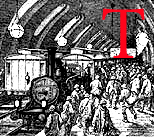[The illuminated initial letter is based upon Gustave Doré’s illustrations to Douglas Jerrold’s London. — George P. Landow]

he spectacular development of massive urban centres, such as Preston, Manchester and Sheffield that housed factories, machinery, and operatives, strongly influenced some Victorian writer’s views of the Industrial Revolution. For example, Mrs. Gaskell’s Mary Barton and Dickens’s Hard Times present intensely gloomy images of working-class life in Manchester and ‘Coketown’ (Preston), the boom town of the earlier industrial period. Gaskell, observing the industrialised north-east from the inside, offers a valuable insight into middle-class fears of working-class violence as exemplified in John Barton. Dickens visiting the north east observes from the outside and offers a devastating critique of Gradgrind’s Utilitarianism practices at work suppressing spontaneous and imaginative response.
Another Eminent Victorian (who very much admired Hard Times and shared Dickens’ attitude to industrialism and its suppression of individual creativity) was the anti-urban and anti-industrial John Ruskin, who avoided urban manufacturing centres on his way north from London to the Lake District. Yet, passing through Matlock in Derbyshire, he was no more than twenty miles from Sheffield, and thirty miles from Manchester. By that time, Sheffield was well established in steel production including, of course, stainless steel. Manchester, or ‘Cottonopolis’, was at the centre of the British cotton spinning and textile manufacturing industries.
However, no matter that these leading Victorians regarded urban industrialism as the enemy, the ‘smoke-clouds of the nineteenth century’ that Ruskin avoided as he travelled through the countryside were ironically the product of an industrial revolution begun in the countryside. You can see this for yourself if you travel to the Lake District from the city of Nottingham in the East Midlands. You leave behind the extended conurbation of the city in which Sir Richard Arkwright established his first horse-powered mill (1769), and drive through the small rural town of Matlock in Derbyshire. On your right you pass the water-powered Masson Mill, which Arkwright had built in 1783 on the banks of the river Derwent. You cannot but be aware of how very little perceptible space you can see between Masson Mill and its immediate backdrop, the Derbyshire Peak District, an area of great and as yet unspoiled natural beauty. Masson Mill, like Arkwright’s Mill at the small Derbyshire town of Cromford is further evidence of the rural origins of the Revolution.


Two scenes from the Peak District. Photographs by George c. 1964 & 1980. [Click on images to enlarge them.]
Pioneers of the industrial revolution like Sir Richard Arkwright and Abraham Darby worked in predominantly rural areas, and initially observers of their nascent revolution celebrated it as something in which to take pride, or at least with which to come to terms. For as ‘localized, provincial and pre-industrial’ structures began to give way to ‘urban, industrial and class-dominated’ structures (Hobsbawm and Ranger, 109), some Victorian writers, such as Thomas Babbington Macaulay, Charles Kingsley, Sir Edward Baines, and Andrew Ure celebrated the dramatic changes, but others, including oddly enough Kingsley unwittingly arguing against himself, began to express their disillusionment with the consequences of the revolution that their countrymen had pioneered. However, the many articles, lectures, and essays on the subject did not, could not, in themselves resolve the dichotomy between the urban and the rural which I have just indicated. This was an important factor in shaping written responses but as matter of social practice, the traditional landed classes resolved it by absorbing into their own ranks the all too willing industrial and commercial parvenus.
Artists and craftsman like Edward Burne-Jones and the socialist William Morris reacted against the ugliness of the urban industrial complex. Although they were not directly involved in the urbanisation of England, and even argued and worked against it, they worked in a privileged margin of aesthetic pursuits, from which they promoted the continuance of rural values in a fantasy England. Whereas writers like Morris argued for abandoning the fruits of the Industrial Revolution altogether, other artists, writers, and composers saw rural England as the true England. The men who advanced this kind of ideal Britain that ignored the existence of industrialization included composers, such as Sir Hubert Parry, 1st. Baronet (1848 -1918), professor of composition and musical history at the Royal College of Music, and successor to the first head of the College, Charles Grove, and simultaneously the Heather Professor of Music at Oxford University. The quintessentially English Ralph Vaughan Williams (1872-1958) also promoted this ideal of a rural England. Prominent literary figures, who also promulgated the image of England as garden, include Alfred Austin William Watson (1858-1935), Alfred Noyes 1880-1958), Sir Henry Newbolt (1862-1938), and the Poet Laurate, Alfred Austin (1835-1913). These men, well placed in the British Establishment, importantly in determined the major cultural values of their age. The main thrust of their work, perhaps instinctively, involved an attempt to cope with the Industrial Beast by spinning fantasies about Merrie England as a great garden. They ignored, or did not realize, that the great Beast came from the garden.
Bibliography
Hobsbawm, Eric and Ranger, Terence. The Invention of Tradition. Cambridge: C.U.P.1983.
Last modified 21 May 2018